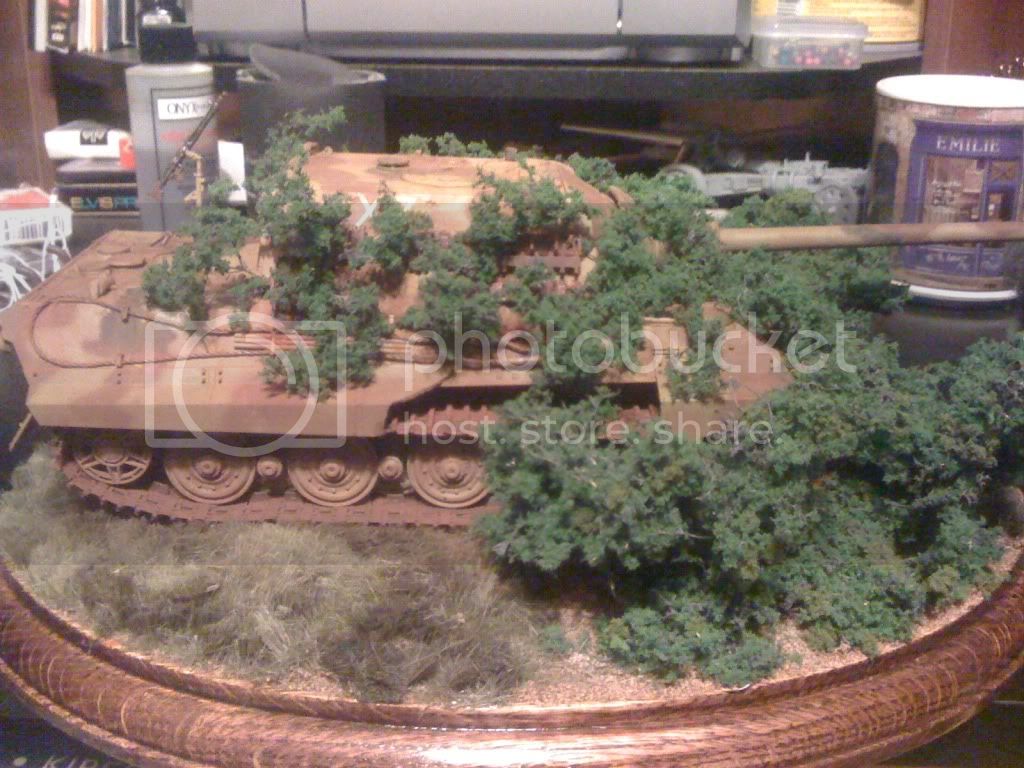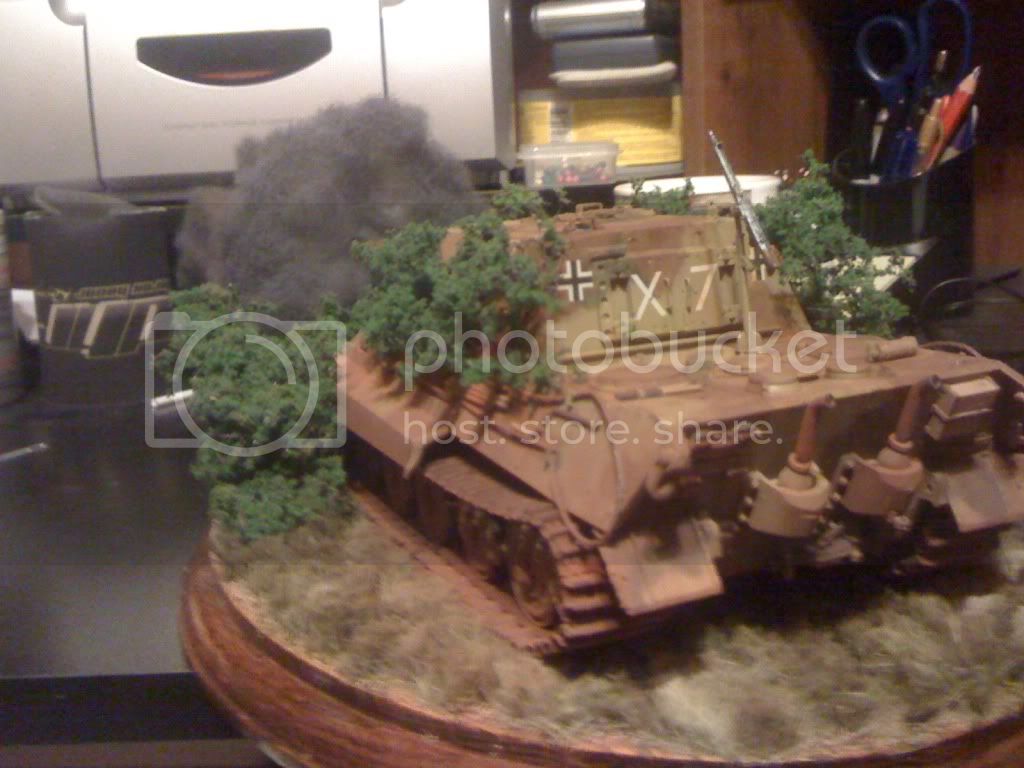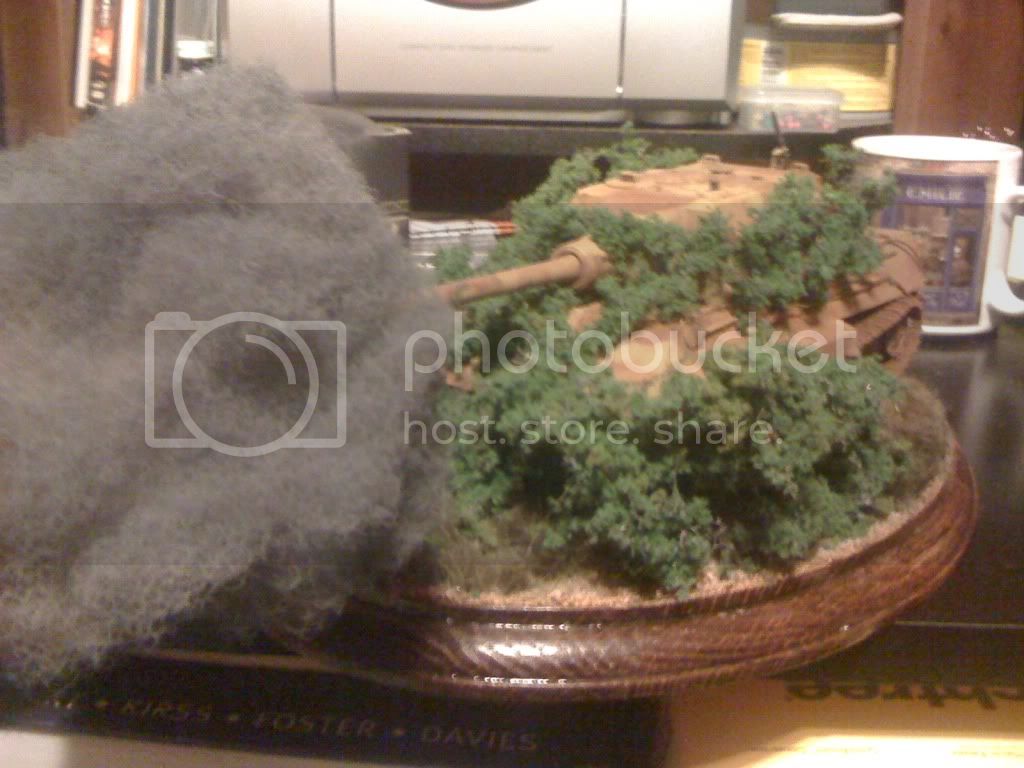Has anyone ever combined 1/35 Military modeling with Railroad flora, NAMELY the railroad trees?
I see some pine trees advertised at 10-12 inches tall, but I'm wondering if they're wide enough to look realistic when a 1/35 figure stands next to them. I realize that these trees are meant for N and HO scale, not 1/35 AFVs and figures. Would the trees look so miniature to make the vignette look funny? If so, what scale would you recommend for mixing military modeling with railroad trees? 1/48? 1/72? Thanks.
Hosted by Darren Baker
Military Modeling and Railroad Flora
Trisaw

Joined: December 24, 2002
KitMaker: 4,105 posts
Armorama: 2,492 posts

Posted: Monday, February 11, 2013 - 05:44 PM UTC
jhoenig

Joined: December 29, 2011
KitMaker: 343 posts
Armorama: 313 posts

Posted: Monday, February 11, 2013 - 11:00 PM UTC
They would look out of place unless they were thinned out (foliage) to look like young inner forest type tree's.
HO scale is 1/87 so even 1/72 scale is pushing it.
HO scale is 1/87 so even 1/72 scale is pushing it.
shermadude

Joined: December 03, 2007
KitMaker: 161 posts
Armorama: 53 posts

Posted: Tuesday, February 12, 2013 - 07:37 AM UTC
Hi Peter,
Go down a few posts and look at the Scenic factory post. They do some really nice looking pine trees in larger sizes. They look good,but the prices are pretty high. Hope this helps.
Regards,Bob
Go down a few posts and look at the Scenic factory post. They do some really nice looking pine trees in larger sizes. They look good,but the prices are pretty high. Hope this helps.
Regards,Bob
CameronForester

Joined: January 11, 2012
KitMaker: 37 posts
Armorama: 36 posts

Posted: Tuesday, February 12, 2013 - 09:38 AM UTC
Scale wise, the larger trees around O gauge would be ok for 1/35 but personally, I think they look kinda cheap. If you have the time, I'd suggest you try making trees from wire. There's a tutorial here on Armorama that is pretty good and a section in Richard Windrow's Terrain Modelling Osprey Masterclass book that is the same general idea but expands on it some.
I have used the railroad foliage to good effect but I wouldn't use the trees. In the following pictures, I used the foliage to camouflage a Jagdtiger and large HO gauge tree armatures to build up the bushes it's hiding in but they're well hidden by the foliage.



I have used the railroad foliage to good effect but I wouldn't use the trees. In the following pictures, I used the foliage to camouflage a Jagdtiger and large HO gauge tree armatures to build up the bushes it's hiding in but they're well hidden by the foliage.



Trisaw

Joined: December 24, 2002
KitMaker: 4,105 posts
Armorama: 2,492 posts

Posted: Tuesday, February 12, 2013 - 03:55 PM UTC
Thanks for the replies. The comments have confirmed my belief about how the railroad trees are too narrow for 1/35 scale.
Cameron, great foliage camouflage effect and the steel wool smoke looks very good!
Cameron, great foliage camouflage effect and the steel wool smoke looks very good!
Posted: Tuesday, February 12, 2013 - 09:17 PM UTC
Somebody had a dio here a few weeks ago with 3 or 4 pre-made pine trees. They were stunning ... and not necessarily cheap either. 


velotrain

Joined: December 23, 2010
KitMaker: 384 posts
Armorama: 320 posts

Posted: Wednesday, February 13, 2013 - 02:02 AM UTC
> "I see some pine trees advertised at 10-12 inches tall, but I'm wondering if they're wide enough to look realistic when a 1/35 figure stands next to them."
It depends on who makes them and what image you want to project. There are many kinds of evergreen trees, and many of them are in fact thin because they're competing with others for scarce sunlight in the forest, and sometimes only the top parts are green.
With perhaps a few exceptions, I'd stay away from the "mainstream, bargain" model RR companies, as they tend to think of pine trees as an ice cream cone turned upside down, with all the branches trimmed uniformly. The Euro producers (Noch, etc.) do a better job at a higher cost. There are also a lot of small shops turning out custom trees on a customer request basis. You tell them what type of tree you want and how large and they'll give you a quote.
Generally speaking, deciduous trees can be produced more quickly and easily than evergreens. The tall pines often involve shaping a long piece of balsa, then drilling lots of holes and inserting various types of material. You can save the big bucks if you're willing to do it yourself. You should be able to get a good sense of the market by doing a search on "custom model trees" or similar. You should also be able to find lots of DIY instruction.
It depends on who makes them and what image you want to project. There are many kinds of evergreen trees, and many of them are in fact thin because they're competing with others for scarce sunlight in the forest, and sometimes only the top parts are green.
With perhaps a few exceptions, I'd stay away from the "mainstream, bargain" model RR companies, as they tend to think of pine trees as an ice cream cone turned upside down, with all the branches trimmed uniformly. The Euro producers (Noch, etc.) do a better job at a higher cost. There are also a lot of small shops turning out custom trees on a customer request basis. You tell them what type of tree you want and how large and they'll give you a quote.
Generally speaking, deciduous trees can be produced more quickly and easily than evergreens. The tall pines often involve shaping a long piece of balsa, then drilling lots of holes and inserting various types of material. You can save the big bucks if you're willing to do it yourself. You should be able to get a good sense of the market by doing a search on "custom model trees" or similar. You should also be able to find lots of DIY instruction.
CameronForester

Joined: January 11, 2012
KitMaker: 37 posts
Armorama: 36 posts

Posted: Wednesday, February 13, 2013 - 04:11 AM UTC
Thank you. The smoke is actually polyester pillow filling glued to a styrene rod in the barrel and airbrushed in layers. It's a somewhat time consuming process trying to get the smoke to look right but it's well worth it.
Also, I've seen some trees from Bachmann that look pretty good. The general rule for large model railroad trees is if they're affordable, they look pretty cheap. If they look good, they're usually expensive. I'd still suggest attempting to make your own from wire. Floral wire is pretty cheap.
Also, I've seen some trees from Bachmann that look pretty good. The general rule for large model railroad trees is if they're affordable, they look pretty cheap. If they look good, they're usually expensive. I'd still suggest attempting to make your own from wire. Floral wire is pretty cheap.
Trisaw

Joined: December 24, 2002
KitMaker: 4,105 posts
Armorama: 2,492 posts

Posted: Wednesday, February 13, 2013 - 06:29 AM UTC
Scenic Express
http://www.sceneryexpress.com/departments.asp?dept=1002
The issue is that the 10-12 inch trees have very narrow trunks that may look funny next to a 1/35 figure. Now I haven't seen these trees in person, but assuming that the 1/35 figure is two inches tall = six feet tall and a tree is 10-12 inches tall or 24-28 feet tall, IF the 1/35 figure's leg is thicker than a 24-28-foot tree trunk that would indeed look kind of odd, wouldn't it? Correct my math if I am wrong. Or do trees grow that tall with the trunk base thickness of a 1/35 figure's leg? Thanks.
http://www.sceneryexpress.com/departments.asp?dept=1002
The issue is that the 10-12 inch trees have very narrow trunks that may look funny next to a 1/35 figure. Now I haven't seen these trees in person, but assuming that the 1/35 figure is two inches tall = six feet tall and a tree is 10-12 inches tall or 24-28 feet tall, IF the 1/35 figure's leg is thicker than a 24-28-foot tree trunk that would indeed look kind of odd, wouldn't it? Correct my math if I am wrong. Or do trees grow that tall with the trunk base thickness of a 1/35 figure's leg? Thanks.

velotrain

Joined: December 23, 2010
KitMaker: 384 posts
Armorama: 320 posts

Posted: Thursday, February 14, 2013 - 01:37 AM UTC
There's another way to use wire for pine trees, and you should be able to find it described on the net. I believe there had been an article on it in a recent U.S. model railway magazine . . . but I just as likely saw it online. You start with two relatively strong wires, cut several inches longer than the height of the tree you want to make.
You put the ends (perhaps taped together) in the chuck of a hand drill. As you twist the wires - tree trunk, you insert cut sections of a much finer wire - narrowing toward the top. Build up the trunk and branches texture as desired, then add your leaf material of choice. I'm just giving the concept, and I suggest tracking down the actual technique before trying it at home. Do not under any circumstance try it with a power drill; at best, the tree will be junk - at worst, yourself.
Charles
You put the ends (perhaps taped together) in the chuck of a hand drill. As you twist the wires - tree trunk, you insert cut sections of a much finer wire - narrowing toward the top. Build up the trunk and branches texture as desired, then add your leaf material of choice. I'm just giving the concept, and I suggest tracking down the actual technique before trying it at home. Do not under any circumstance try it with a power drill; at best, the tree will be junk - at worst, yourself.
Charles
 |











